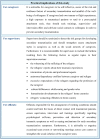Secondary Traumatization in Caregivers Working With Women and Children Who Suffered Extreme Violence by the "Islamic State"
- PMID: 29922186
- PMCID: PMC5996169
- DOI: 10.3389/fpsyt.2018.00234
Secondary Traumatization in Caregivers Working With Women and Children Who Suffered Extreme Violence by the "Islamic State"
Abstract
Introduction: Refugees fleeing persecution, torture, or sexual violence are at high risk of developing both acute and chronic psychological disorders. Systematic violence, as committed against the Yazidi minority in Northern Iraq by the terror organization known as the Islamic State (IS), can be seen as a particularly traumatic burden to the victims, but also to caregivers providing treatments and assistance to them. The intense exposure to traumatic content may cause secondary traumatization in respective caregivers. This study aims (1) to identify the prevalence of secondary traumatization in caregivers working with traumatized women and children from Northern Iraq; (2) to determine the specific distressing factors and resources of the caregivers; as well as (3) to analyze whether caregivers' personal history of trauma or flight, attachment styles, working arrangements as well as support offers qualify as risk or resilience factors for secondary traumatization. Materials and Methods: In this cross-sectional study, N = 84 caregivers (social workers, psychotherapists/physicians, and interpreters) in the context of a Humanitarian Admission Program (HAP) for women and children traumatized by the so called IS were investigated about their work-related burdens and resources. Secondary traumatization was assessed with the Questionnaire for Secondary Traumatization (FST). To identify relevant determinants for secondary traumatization multiple linear regression analyses were performed. Results: Secondary traumatization was present in 22.9% of the participating caregivers, with 8.6% showing a severe symptom load. A personal history of traumatic experiences, a personal history of flight, a higher number of hours per week working in direct contact with refugees as well as a preoccupied attachment style were detected as risk factors for secondary traumatization. A secure attachment style could be identified as a resilience factor for secondary traumatization. Discussion: Caregivers working with traumatized refugees are at high risk of developing secondary traumatization. Based on the findings of this study and theoretical considerations, a framework of classification for different types of trauma-associated psychological burdens of caregivers working with traumatized refugees is proposed. Implications for the training and supervision of professionals in refugee- and trauma-care are discussed.
Keywords: Yazidi; attachment style; caregiver; genocide; refugees; resilience; secondary traumatization; trauma.
Figures






References
-
- UN Refugee Agency Figures at a Glance (2017) Available online at: http://www.unhcr.org/figures-at-a-glance.html (accessed April 17, 2018).
-
- Bundesamt für Migration und Flüchtlinge Schlüsselzahlen Asyl 2017 (2018). Available from: http://www.bamf.de/SharedDocs/Anlagen/DE/Publikationen/Flyer/flyer-schlu... (accessed April 17, 2018).
-
- Bozorgmehr K, Mohsenpour A, Saure D, Stock C, Loerbroks A, Joos S, et al. Systematische Übersicht und “Mapping” empirischer Studien des Gesundheitszustands und der medizinischen Versorgung von Flüchtlingen und Asylsuchenden in Deutschland (1990–2014). Bundesgesundheitsblatt Gesundheitsforschung Gesundheitsschutz (2016) 59:599–620. 10.1007/s00103-016-2336-5 - DOI - PubMed
-
- Steel Z, Chey T, Silove D, Marnane C, Bryant RA, Van Ommeren M. Association of torture and other potentially traumatic events with mental health outcomes among populations exposed to mass conflict and displacement: a systematic review and meta-analysis. JAMA (2009) 302:537–49. 10.1001/jama.2009.1132 - DOI - PubMed
LinkOut - more resources
Full Text Sources
Other Literature Sources
Miscellaneous

